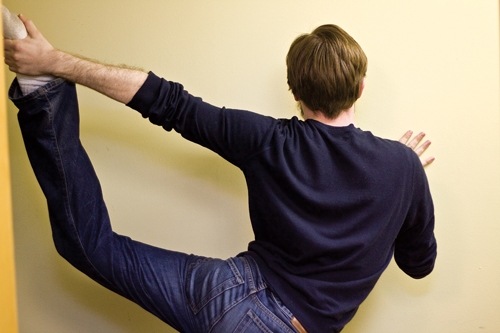Why stretching pre-and-post-workout is worth your time
Michaela Halbert
Contributor

Stretching is often neglected. What most people don’t realize is that leaving stretches out of any fitness routine is like never washing your dishes. Sure, you might be able to eat a few meals without getting your hands wet, but eventually you’ll be putting your health at risk. Just like dishwashing, stretching is a maintenance activity that is necessary for long term health.
If you run or cycle frequently, you most likely have a tight iliotibial band. This fibrous tissue runs from the hip to the knee and attaches to many muscles found in the thigh, making it a major contributor to lower body locomotion.
If you are a swimmer, you are likely to experience some tightness through the neck and shoulders. Simply walking across campus can lead you down a dark path to tight hip flexors, a muscle group responsible for pulling the knee upwards. All of these conditions can be lessened, if not avoided altogether, by incorporating stretches into your fitness routines. Stretching is for everybody.
The connection made between yoga and a healthy body and mind has made it a popular choice among the health conscious in recent years. Its collection of stretch-based poses has, to a large extent, directed attention to the importance and benefits of stretching. And while the attendance of yoga classes seems to be on the rise, Justin Sanderson, a York student who works as a
trainer at the Tait McKenzie Centre, says he finds that there are still a considerable number of people who do not stretch regularly.
“I find it’s half-and-half,” he says. “Those people who know that stretching is good for them are the ones taking the time to stretch after working out.”
The act of stretching involves lengthening the muscles in preparation for work. It can be done pre-workout, or in preparation for rest if properly incorporated into the cool-down phase. Stretches can either be classified as static or dynamic. This distinction is made based on the nature of the stretch.
Completion of a static stretch involves holding a muscle, or muscle group, taut in one position for a set amount of time. This type of stretch works to facilitate the removal of waste material, such as lactic acid, produced by the muscles during exercise. Pain and discomfort ensue when such waste material is left to accumulate within the muscle over time.
Sanderson says that this is the more important stretching type of the two, but warns against using static stretches on cold muscles (those that have not been active). With that said, it is best to do your static stretches post activity. A common static stretch that can easily be incorporated into any routine is the hamstring stretch. To do this, sit on the floor with both legs straight out in front of you. Bend at the hip and reach for your toes.
Stretching has been praised for its ability to improve posture and flexibility. Sanderson emphasizes the importance of good flexibility in everyday life: “by increasing range of motion, you prevent injury.”
Dynamic stretches involve
subjecting a muscle, or muscle group, to a repetitive motion for a short period of time. This motion promotes blood flow to
the muscles and lubricates joints, preparing the body for work. Dynamic stretching is often used by sports teams prior to activity. Unlike static stretches, dynamic stretches are best executed prior
to exercise, rather than after.
A common dynamic stretch is the shoulder roll. To complete a shoulder roll, move the shoulders up, as if you were shrugging, and then, in a circular motion, drop them back down.
Finally, in order to get the most out of your stretching, it is important to note the following. A thorough routine should be five to ten minutes in duration, dedicating 15 to 20 seconds to each muscle.
Oxygen plays an important role in stretching and deep breathing circulates oxygen best. The saying “no pain, no gain” should not be applied to stretching.
It is important to feel some pull in the muscle, stretching further on the exhale, but stretching shouldn’t hurt. Also, some equipment, such as foam rollers, can be used to enhance results. So next time you want to skip the stretching, think about that sink full of grungy dishes. Is that what you want for your muscles?


